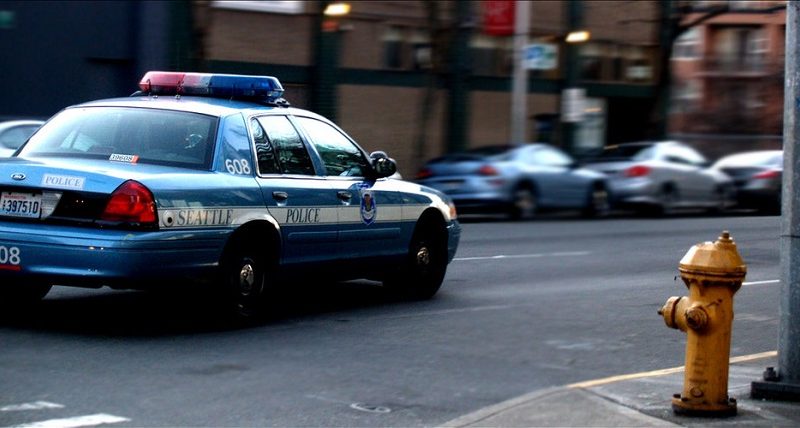15 Years Later: Virulent Racism or “the Race Card”?
On Jan. 25th, 2002, columnist for the Seattle Post-Intelligencer, Robert L. Jamieson, wrote about a seemingly routine traffic stop between a Seattle police officer and some pedestrians.
According to Jamieson, officer Jess Pitts, then 49, confronted a group of Asian students who were jaywalking in a high-traffic area of Seattle’s International District. Pitts was concerned about the group’s safety, so he pulled his police car along the curb to stop them and share a quick lesson.
“Who here can tell me how we cross a street in Seattle?” Pitts asked. When the students appeared confused and did not immediately reply, he asked if they spoke English.
He later explained that he asked that question because of an influx of Japanese tourists to the area—it was Ichiro Suzuki’s debut year with the Seattle Mariners. Pitts just wanted to be sure the individuals could understand him. He didn’t mean to be unkind.
The Asian students didn’t take it that way.
They had just come from a workshop on racial profiling and, Jamieson says, jumped at the chance to denounce Officer Pitts’ “sarcastic and demeaning” tone as racism.
Pitts rebutted, saying the students themselves were “gesturing, laughing, making jokes, distracting the group from being able to listen, and challenging [authority].” One female student even approached Pitts and screamed at him, forcing him to call back-up.
After all was said and done, the students filed a complaint with the Seattle P.D.’s Office of Professional Accountability, which censured Pitts by giving him a CUBO (Conduct Unbefitting of an Officer) letter in his personnel file.
To Jamieson, this was a farcical miscarriage of justice. Pitts was a commended Air Force veteran doing his part to keep the streets of Seattle safe; the students wanted to use him as a scapegoat to make a point. In Jamieson’s words, “The race deck was stacked.”
WHAT JAMIESON GOT WRONG
(I.E., MOSTLY EVERYTHING)
Now, I’d like to invite you to visualize this incident in your mind. How many students do you see? Three or four? As many as ten?
Pitts stopped thirty Asian American students for jaywalking that fateful summer day, and that’s only the tip of the iceberg when it comes to facts Jamieson distorted or got plain wrong.
Jamieson wrote his article a full six months after Pitts stopped the students in July 2001. He neglected to interview any of the students or the four eyewitnesses who later came forward. He also refused to look at Pitts’ court testimony, which he could have picked up if he’d made the 20-minute drive from the Seattle P.I. headquarters to the King County Courthouse.
Jamieson’s only source was a report by the police department’s Office of Professional Accountability: a report filed about an officer, by officers.
Now, you’re probably wondering— and rightfully so—where I got this information. I learned about this case when Dr. Andrew Cho, a sociology instructor from Tacoma Community College, visited our TSOC 270 class a couple weeks back. Cho gave us Jamieson’s article to read and then asked us if Pitts deserved the CUBO letter in his file (the lightest possible punishment he could have received).
Most of the class said no. Pitts could have acted better but was ultimately doing his job.
Then Cho played a news clip, revealing that he was one of two teachers chaperoning the students back in 2001.
The students had given up their vacation to take part in a work-intensive summer leadership program. They never attended a workshop on racial profiling, as Jamieson alleged; they had just eaten lunch and were walking to an art museum to see works by Asian American artists.
Cho, his colleague, and their students were crossing the intersection at 4th Ave. S and Main Street at a marked cross-walk when Pitts stopped them.
Four witnesses who were eating lunch across the street at the time recalled the officer forcing the group to line up against a dirty building wall.
Cho remembers thinking, “Why is this officer so angry, and why is he picking on our group of good kids, just minding our own business?”
Pitts would retain and verbally abuse Cho and his students for the next 45 minutes.
“I’VE KILLED PEOPLE LIKE YOU”
Cho recalls the various ways Pitts antagonized the group, causing many of the students to become “confused, scared, and upset.”
Pitts used a “fake Asian accent” to repeatedly ask if they spoke English. He conducted an unlawful search of one of the male students, An Nguyen, and later testified that he “looked like the type” who would have a weapon on him. One of the officers Pitts called in for back-up grabbed 17-year-old Thao Le by the arm and made her cry, according to the Kitsap Sun.
Pitts also mistook Cho, who is Burmese, for being Vietnamese. He got in his face and told him, “I’ve killed people like you [in the war].”
Thao Le was the only one in the group of 30+ people to receive a citation for jaywalking. She contested the $38 ticket in court, classmates at her side, and gave Pitts a chance to own up to his actions.
Pitts denied all wrongdoings despite photographic evidence (one student photographed the others lined up against the wall) and four eyewitnesses who corroborated the students’ story. Then he changed his tune: he hadn’t held the group against their will. They’d been free to leave at any time.
Pitts never received punishment beyond the letter in his file. “He got off way, way too lightly,” Cho says.
Cho’s students also had difficulty coping with what had happened to them. He says some of them experienced severe PTSD and “would start shaking with fright whenever they saw a police car or police officer.”
CALL IT WHAT IT IS: ORIENTALISM
Beyond Pitts’ actions, the crux of this story is that Jamieson concocted a false story about race cards and police scapegoats to silence a group of Asian students who suffered a very real act of injustice and cruelty.
Tanya Velasquez, an instructor with UW Tacoma’s Ethnic, Gender, and Labor department, has no doubt that Pitts drew on Orientalist tropes about Asian Americans in his decision to harass them.
“His desire to use his power in an oppressive way in that moment is really at the heart of the story,” she says. “What made it easier for him to do that is precisely because it was a group of Asian students. [He had] preconceived ideas about their vulnerability, lack of citizenship, language skills… then to capitalize on that to bully them for 45 minutes is overtly racial.”
As for Pitts’ assertion that he only cared about the students’ safety, Velasquez says, “To frame it as protecting them… that tells me he felt quite justified in his behaviors. This is speculation, but I would argue he was surprised there was even a court date. If he’s drawing on stereotypes about Asians in the first place, he was probably assuming they would be submissive, quiet, and docile about this injustice. In fact, I’m sure he was counting on it.”
EPILOGUE
Inspired by Cho’s story, a student once emailed Jamieson asking why he had deliberately omitted important sources from his articles. Jamieson replied to the girl saying he was a columnist, not a journalist, and therefore not responsible for carrying out the same journalistic standards.
“I thought college students were supposed to be smart,” he wrote. “You must be one of the dumb ones.”
I don’t think she is, Mr. Jamieson. I don’t think she is.







